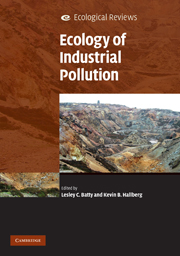Book contents
- Frontmatter
- Contents
- List of contributors
- Preface
- Acknowledgements
- 1 Consequences of living in an industrial world
- 2 Metallophytes: the unique biological resource, its ecology and conservational status in Europe, central Africa and Latin America
- 3 Lichens and industrial pollution
- 4 The impacts of metalliferous drainage on aquatic communities in streams and rivers
- 5 Impacts of emerging contaminants on the environment
- 6 Ecological monitoring and assessment of pollution in rivers
- 7 Detecting ecological effects of pollutants in the aquatic environment
- 8 With the benefit of hindsight: the utility of palaeoecology in wetland condition assessment and identification of restoration targets
- 9 An ecological risk assessment framework for assessing risks from contaminated land in England and Wales
- 10 Diversity and evolution of micro-organisms and pathways for the degradation of environmental contaminants: a case study with the s-triazine herbicides
- 11 The microbial ecology of land and water contaminated with radioactive waste: towards the development of bioremediation options for the nuclear industry
- 12 The microbial ecology of remediating industrially contaminated land: sorting out the bugs in the system
- 13 Ecological recovery in a river polluted to its sources: the River Tame in the English Midlands
- 14 Manchester Ship Canal and Salford Quays: industrial legacy and ecological restoration
- 15 Large-scale mine site restoration of Australian eucalypt forests after bauxite mining: soil management and ecosystem development
- 16 Sustaining industrial activity and ecological quality: the potential role of an ecosystem services approach
- Index
- Plate section
- References
13 - Ecological recovery in a river polluted to its sources: the River Tame in the English Midlands
Published online by Cambridge University Press: 05 June 2012
- Frontmatter
- Contents
- List of contributors
- Preface
- Acknowledgements
- 1 Consequences of living in an industrial world
- 2 Metallophytes: the unique biological resource, its ecology and conservational status in Europe, central Africa and Latin America
- 3 Lichens and industrial pollution
- 4 The impacts of metalliferous drainage on aquatic communities in streams and rivers
- 5 Impacts of emerging contaminants on the environment
- 6 Ecological monitoring and assessment of pollution in rivers
- 7 Detecting ecological effects of pollutants in the aquatic environment
- 8 With the benefit of hindsight: the utility of palaeoecology in wetland condition assessment and identification of restoration targets
- 9 An ecological risk assessment framework for assessing risks from contaminated land in England and Wales
- 10 Diversity and evolution of micro-organisms and pathways for the degradation of environmental contaminants: a case study with the s-triazine herbicides
- 11 The microbial ecology of land and water contaminated with radioactive waste: towards the development of bioremediation options for the nuclear industry
- 12 The microbial ecology of remediating industrially contaminated land: sorting out the bugs in the system
- 13 Ecological recovery in a river polluted to its sources: the River Tame in the English Midlands
- 14 Manchester Ship Canal and Salford Quays: industrial legacy and ecological restoration
- 15 Large-scale mine site restoration of Australian eucalypt forests after bauxite mining: soil management and ecosystem development
- 16 Sustaining industrial activity and ecological quality: the potential role of an ecosystem services approach
- Index
- Plate section
- References
Summary
Introduction
In many industrialised regions particularly in Britain, rivers have been impounded for use by mills, polluted by multiple point sources and channelised to the very source over many centuries (e.g., Bracegirdle 1973; Lester 1975; Harkness 1982; Holland & Harding 1984; Haslam 1991). Since the 1960s, the ecological recovery of such historically polluted and disturbed rivers in Britain has been remarkable. Long reaches of once black, foetid, fishless watercourses, some almost completely devoid of macroscopic biota, have been transformed into clear streams and rivers with diverse floras and faunas and prolific fish populations. This transformation is perceived to have been the result of a number of factors, including law, public pressure, new technologies, new infrastructure and changes in the economy and industry. Even so, ecological recovery is still poorly advanced in some rivers and the reasons for this have not been explained in any detail. This short chapter uses sets of long-term chemical and biological data from three sites on a Midland river in a preliminary analysis of the possible reasons for the variable rates of ecological recovery and the relationship between the long-term chemical and biological changes in the river. It is part of a series of longer term studies of the problems associated with ecological recovery of polluted rivers (e.g., Langford et al. 2009).
- Type
- Chapter
- Information
- Ecology of Industrial Pollution , pp. 255 - 275Publisher: Cambridge University PressPrint publication year: 2010
References
- 2
- Cited by



